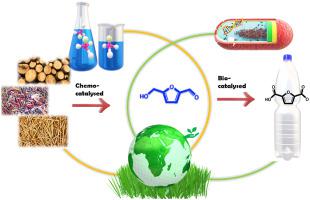Biomass & Bioenergy ( IF 5.8 ) Pub Date : 2022-05-13 , DOI: 10.1016/j.biombioe.2022.106474 Roopa D. Parate , Mahesh S. Dharne , Chandrashekhar V. Rode

|
Biomass being a renewable source of energy, has emerged as an attractive target for manufacturing valuable products. These possibilities can be explored to meet the current need for degradable plastic, 2,5-furandicarboxylic acid (FDCA). Integration of chemical and biological approaches for direct biomass conversion into FDCA was evaluated in this study. 5-hydroxymethylfurfural (5-HMF) was chemo-catalytically obtained from fructose using recyclable amberlyte IR-120 as a catalyst with >98% purity. Klebsiella oxytoca NCIM 2694 bacterial strain showed the potential of converting 98% of 5-HMF into FDCA with 58% selectivity at 96 h. With optimized conditions of pH 7, 37 °C, 2 g whole cells, we reported 99% 5-HMF conversion to FDCA with 95% selectivity at 72 h and 2667 mg L−1 yield, with 39 mg L−1 h−1 productivity. This is the highest yield obtained with the substrate concentration as high as 3000 mg L−1 reported till date. While the bacterial tolerance to 5-HMF observed was for the highest 5-HMF concentration of 4000 mg L−1, with 99% conversion however, compromising the FDCA yield to 2447 mg L−1 and 32 mg L−1 h−1 productivity. Atom economy of 85% and E factor of 17.71 g g−1 was obtained as a measure of its efficiency and sustainability of the process. The developed process will decrease the cost by excluding any extra nutrient supplement, complete substrate utilization, highest FDCA selectivity/productivity and higher tolerance by K. oxytoca, sequentially catalyzing the oxidations by a single route for FDCA synthesis from renewables.
中文翻译:

从果糖衍生的 5-羟甲基糠醛化学和生物催化合成 2,5-呋喃二甲酸
生物质作为一种可再生能源,已成为制造有价值产品的有吸引力的目标。可以探索这些可能性以满足当前对可降解塑料 2,5-呋喃二甲酸 (FDCA) 的需求。本研究评估了将生物质直接转化为 FDCA 的化学和生物方法的整合。5-羟甲基糠醛 (5-HMF) 是使用可回收的 amberlyte IR-120 作为催化剂从果糖中化学催化获得的,纯度 > 98%。Klebsiella oxytoca NCIM 2694 菌株显示出在 96 小时将 98% 的 5-HMF 转化为 FDCA 的潜力,选择性为 58%。在 pH 7、37 °C、2 g 全细胞的优化条件下,我们报道了 99% 的 5-HMF 转化为 FDCA,在 72 h 和 2667 mg L -1时选择性为 95%产率,39 mg L -1 h -1产率。这是迄今为止报道的在底物浓度高达 3000 mg L -1时获得的最高产率。虽然观察到的细菌对 5-HMF 的耐受性是 4000 mg L -1的最高 5-HMF 浓度,但转化率为 99%,FDCA 产量降低至 2447 mg L -1和 32 mg L -1 h -1生产率. 85% 的原子经济性和17.71 g g -1的E因子获得作为其效率和过程可持续性的衡量标准。所开发的工艺将通过排除任何额外的营养补充、完全的底物利用、最高的 FDCA 选择性/生产率和更高的催产酸钾耐受性来降低成本,通过单一途径从可再生能源合成 FDCA 依次催化氧化。











































 京公网安备 11010802027423号
京公网安备 11010802027423号